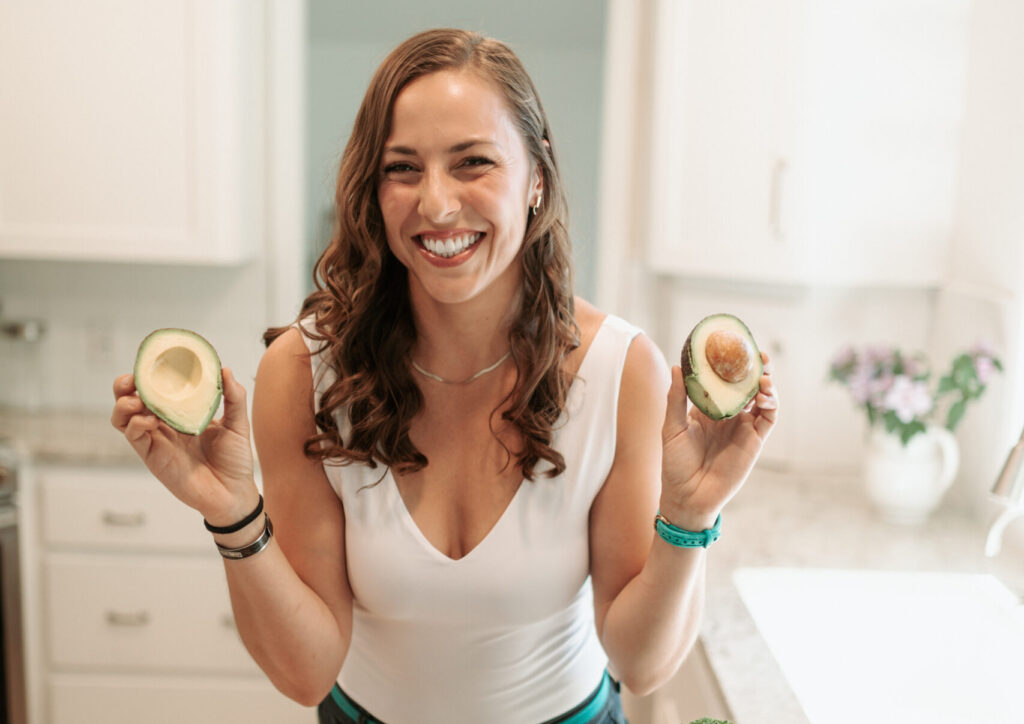AVAILABLE WHEREVER YOU LISTEN TO PODCASTS!
Have you been struggling to break free from your sugar addiction? We all have cravings for sweet and yummy foods that are hard to resist.
In today’s Episode of the Fitness Simplified podcast, your Host, Fitness & Nutrition Specialist Brooke Davis, delves into an intriguing topic that many of us can relate to – sugar addiction. As a women’s fitness and nutrition specialist, she understands the complexities of this subject and offers valuable insights on how to overcome it. While the existence of sugar addiction is still a matter of debate, the lure of hyper-palatable foods can be challenging to resist. Brooke shares practical tips on how to reduce cravings for these foods, create healthy habits, and retrain our brains to think differently.
So, let’s dive in and discover how we can retrain our brains to make healthier food choices!
Transcript:
Welcome to the Fitness Simplified Podcast. I’m Brooke Davis, Women’s Fitness and Nutrition Specialist with B. Davis Training, and I’m here to simplify your fitness.
This is a hot, hot topic, and I am so excited to dive into it!
Are you addicted to sugar? Well, there are so many cofactors in a question like this, let’s talk. The main study cited in this statement and this argument that we see all over the internet was a rat study. They took a group of rats, they deprived them of food for 12 hours, then gave them 12 hours of access to a high-sugar solution.
After a month, what happened were a few things: One, they were noted to have started binging tendencies or unusually large bouts of intake. Two, they demonstrated withdrawal symptoms through signs of anxiety and depression. And number three, they demonstrated craving through an enhanced response to that sugar. All of these things indicate what scientists would consider an addiction to a substance. There are a few other interesting facts about sugar that lead people to think that they are addicted.
Intermittent sugar access actually uses opioid pathways in the brain and releases dopamine and mimics other chemical processes of an actual drug addiction. While the behavior and chemical patterns specifically in rats lead to what one may consider an addiction, the debate still remains. The term “addiction” in and of itself has different definitions from mental and physical perspective of side effects, as well as the term dependence, which is described by uncontrollable behaviors.
These are hard to determine in lab rats. The other consideration with humans is that most of our food and patterns of overeating don’t just include sugar, right? No one is just eating spoonfuls of sugar claiming to be addicted. The tendency is to eat an array of what’s called hyper palatable foods.
These hyper palatable foods are scientifically engineered to have an exceptionally high concentration of wording flavors like sugar, salt, and fat. The combination of these ingredients is what creates a super sensory experience that essentially overrides our body’s natural cues of satiety or fullness or, you know, lack of craving. These foods are actually crafted to trigger the release of neurotransmitters like dopamine associated with pleasure and reward in the brain, like once you pop the fun don’t stop, right? So literally the perfect recipe for overconsumption.
Scientists and food technologists actually work together to create the ideal food formulations. And through extensive research, they have identified what’s called the “bliss point” or the precise level of sweetness, saltiness, or fattiness that triggers maximum pleasure in consumers. This calculated manipulation of ingredients and ratios is what makes hyper palatable foods incredibly enticing, hard to put down, and the fact that we have such an immense and so much access to them makes them hard to avoid.
Hyper palatable foods typically share certain characteristics that make them prone to overconsumption. So one is the intense flavor profile. Again the combination, it’s the proper ultimate combination of usually it’s sweet and fatty, salty and fatty, or sweet and salty.
And these tastes, that combination is what drives us to overconsume these foods. Number two is texture. So food manufacturers actually pay really close attention to the texture and the mouthfeel of these foods, aiming for the perfect balance of crunchiness, creaminess, or smoothness.
These help enhance the sensory experience and actually, again, make it harder to resist indulging in larger quantities. And the last one is the absence of satiety signals. So fullness, satiety is fullness.
So hyper palatable foods can actually disrupt our body’s natural signals of satiety, making it difficult to recognize when we’re full and to stop eating them. The quick absorption of sugar, lack of fiber and protein content in all of these foods actually fail to activate the hormonal response that signals fullness. This leads to us just eating and eating until we feel sick.
So again this isn’t technically categorized as addiction per se. I feel like there’s an argument to it, right? When something registers in our brain chemically the same way something we can consider a drug does, despite it maybe not having the same exact withdrawal patterns, I think there’s cause for concern to be sure. But that all being said, knowledge is power. So now that you know how these foods can impact you, there are a few things you can do to prepare for them.
Number one is to get enough nutrient-dense foods to curb your hunger, balance your blood sugar, which will absolutely reduce your cravings. Within that concept, making sure that you’re getting enough protein, making sure that you’re getting enough fiber. Those two things are going to help promote fullness and satiety so that you’re not craving other things.
Number two is to stay hydrated, making sure that your body is absorbing the water so you have maybe an electrolyte blend. Those minerals are going to again reduce cravings. If you’re thirsty, a lot of times that can feel like hunger.
Number three, create habits that keep those kinds of foods out of your regular sphere of living, essentially, right? Don’t buy them, stay to the edge of the grocery store, don’t shop hungry, go with a list.
And number four, invest in some accountability and some direction on how to actually achieve this. Because once you cut these foods out, you honestly do stop craving them. And once you’re out of the habit of buying them, or stopping at that fast food store, you literally can retrain your brain to not go for those things anymore.
I was talking to a friend the other day, and I say this not out of like a place of being on my high horse, because I grew up going to McDonald’s. We went at least on a weekly basis. I loved Happy Meals, the toys that came in them, I was all about it. But I haven’t been to McDonald’s, I literally couldn’t tell you the last time I went. And when I’m hungry in town driving around, McDonald’s does not come to mind as an option.
I have my staple places that I go that I know are going to serve my goals and my needs. And that’s what comes up because those are the only places I ever go. The concept of neuroplasticity, our brains are constantly making new connections.
So the more that we can train our brain to not go for those foods and not crave them, and honestly, not even think about them, the easier it’s going to be to avoid them. So keep that in mind. I would love to hear your thoughts on this.
If you have something, let me know. Give me some feedback on this.
If you have any questions, suggestions for future topics, or just want to chat, feel free to reach out to us on Instagram @Brooke_Elysian and Facebook linked in the show notes or via our website, Elysianwomenswellness.com. And if you enjoyed what you heard today, we’d be thrilled if you could take a half second to leave us a five-star review. Not only will you be helping others find our show, but you’ll also be entered into our monthly hundred dollar giveaway for new reviews. New episodes drop every Monday, so make sure to hit that subscribe button and stay tuned for more.
Thanks for listening. See you soon.
Coach Brooke Davis Links:
LinkedIn: Brooke Davis
Facebook: Brooke Davis, CPT
Instagram: Brooke Davis (@brooke_elysian)
Free Community: Women’s Fitness Simplified: Lean down, tone up, build confidence!

Women’s Functional Nutritionist & Fitness Specialist along with CEO of Elysian Women’s Wellness.
God, family, fitness – in that order. Fitness isn’t my job, it’s my passion. My favorite things include traveling the world, being a mama and making a difference.
14 years of experience in the wellness industry has brought me to an understanding that when you’re ready – you’ll do it. So when you are, we’re here to keep you simply well.
The last “program” you’ll ever buy. Your individualized training & nutrition plan that teaches the why & how to create lasting changes with me by your side every step of the way!

Error: No feed found.
Please go to the Instagram Feed settings page to create a feed.
Level 0, 1, 2 & 3: Level Up your workouts with beginner to advanced plans designed with a focus lift each month, progressive overload, instructional videos & all inclusive training & nutrition guides.
Copyright ©2025. Gamechanger
A BRANDT CREATIVE CO. TEMPLATE. Trusted by Wimgo.